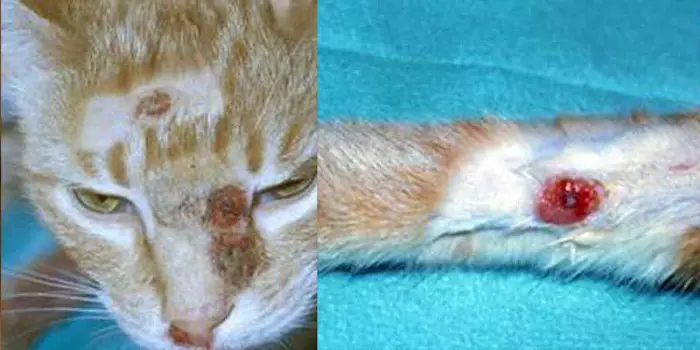Cat pox virus is the viral infection of feline species related to human chicken pox. The virus is closely related to the cowpox virus that causes skin lesions in the udder and teats of dairy cattle. Feline pox virus causes small skin lesions at the neck, legs, ears, muzzle, and head region.
Causes of Cat Pox Infection
The most common poxvirus infection of cats is cowpox, caused by an Orthopoxvirus, but infection with Parapoxvirus is an uncharacterized virus under the family Poxviridae. Cat pox has been reported in North America and India.
Transmission of Feline Pox Virus
Cats’ usual route of cowpox infection is skin inoculation, probably through a cat bite or other skin wound. It is also possible to become infected with the cat pox virus through the nose. Local viral replication produces a primary skin lesion and spreads to the draining lymph nodes, and a leukocyte-associated viremia gives rise to widespread secondary skin lesions.
Clinical Signs of Cat Pox Infection
The Feline Cowpox virus usually causes widespread skin lesions, but most cats have a history of single primary skin lesions, generally on the head, neck, or forelimb.
- Primary lesions are often complicated by concurrent bacterial infection and may vary from a small superficial scabbed over the wound to a large abscess of the area of cellulitis.
- Secondary skin lesions generally developed 1 to 3 weeks later.
- First apparent as randomly distributed, small epidermal nodules, the lesions increase in size.
- These gradually dry and, after 4 to 5 weeks, exfoliate.
- New hair growth soon occurs, although some lesions may result in small, permanently bald patches.
- Many cats show no clinical signs other than skin lesions.
- Cats may be pyrexic, inappetent, or depressed, and a few may have coryza or transient diarrhea.
- Severely ill cats have a poor prognosis, and euthanasia may be advised.
Diagnosis of Feline Pox
Presumptive diagnosis is based on characteristics of clinical signs.
- Dried scab material can be sent to a laboratory by mail in a sealed container without a transport medium.
- Cowpox virus can be readily isolated in a variety of cell cultures.
- Seru antibodies can be detected by various methods, like the Immuno Flurocesce Antibody (IFA) assay for cowpox is helpful.
- Electron microscopy.
Treatment of Catpox Infection
There is no specific treatment for cat pox virus infections.
- Broad-spectrum antibiotics are recommended to control secondary bacterial infections.
- General supportive therapy, including fluids, may be necessary.
- Glucocorticoids are contraindicated because they may exacerbate the condition.
Prevention of Feline Pox Virus
The preventive measures for feline poxvirus are as follows:
- The vaccines are available, but the vaccinia virus may be considered valuable.
- Vaccinia viruses appear to be of low infectivity and pathogenicity for cats and cheetahs, but their ability to provoke a protective immune response is unknown.
- Maintain healthy living for your cat.
- Keep the cat house clean and free from contamination.
